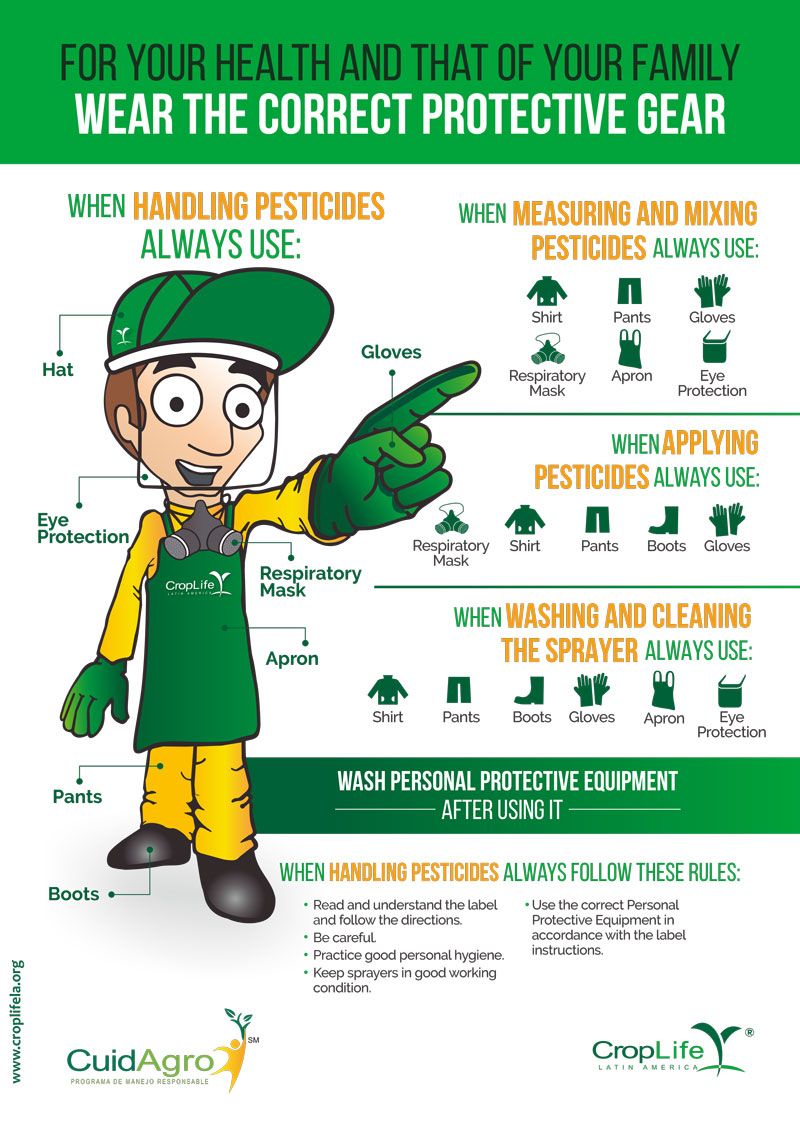Personal Protective Equipment (PPE) for the application of agrochemicals
To achieve a successful production, a series of factors must be met, ranging from soil preparation, seed quality, agrochemical application, crop management and harvesting.
The timely application of agrochemicals in all its forms (fungicides, insecticides, herbicides and other groups), ensures us to obtain good quality crops. All these products applied according to the technical recommendation or the farmer's experience, help the crops achieve a good development, both in the roots and in the aerial part, as they protect them from the attack of pathogens and provide nutrients.
Like all chemical products, these can cause negative effects on people, if the corresponding preventive measures and safety equipment are not used. Within the effects that an agrochemical can cause in the human body, we have:
- Pesticide poisoning symptoms
- Nausea, headache, dizziness, chest discomfort, skin blisters, diarrhea, blurred vision.
- Advanced poisoning symptoms
- Vomiting, difficult breathing, dilated pupils and unconsciousness
All pesticide containers must carry a label, which must include instructions in the language spoken in the country in which the product was registered, and must indicate the personal protective equipment that must be used for the application and the care after the application.
Crop managers should evaluate in the first instance, if it is necessary to apply pesticides. Once the decision is made to apply them, we should choose a product that is effective against the pest we wish to combat and, at the same time, consider reducing the dangers for the applier and the environment. Buying agrochemicals must be done in a place designed for this purpose, which must have an agronomist or a technician trained to recommend the best option for the problem one wishes to combat.
The selection and purchase of the equipment that will be used for applying pesticides is important. For example, there may be various types of spraying equipment on the market, but the cheapest ones are often not the best from a safety point of view. They can be of poor quality and have leaks. The same applies to the choice of personal protective equipment. (https://training.itcilo.it/actrav). The organization of working time, particularly in the hot weather, is important in this respect. Spraying agrochemical products, for instance, must be done in the coolest hours of the day.
All pesticide handlers (applicators, mixers/loaders) have a legal obligation to follow all PPE instructions that appear on the product label. A pesticide label indicates the minimum PPE a person must use in the performance of handling activities.
Below are the different gears that can be used for protecting applicators:
Personal hygiene
Personal hygiene aims to keep the body clean and not allow any harmful element to remain in it for a long period, as it can be absorbed by the skin. It is equally important to avoid breathing or ingesting small and even insignificant amounts of agrochemicals due to its harmful effects to the health.
The basic rules of personal hygiene when using agrochemicals are the following ones:
- Avoid exposure to agrochemicals by following good practices and using protective clothing and equipment when necessary.
- Thoroughly wash the exposed parts of the body after work, before eating, drinking or smoking, and after using the toilet or sanitary service.
- Regularly examine the body to make sure the skin is clean and in good health.
- Protect any part of the body in which there are cuts or inflammations.
- Avoid self-contamination at all times, particularly when decontaminating or removing protective clothing.
- Never use unsafe practices, such as blowing through sprayer nozzles to unlock them (always use a soft probe).
- Do not carry contaminated items such as dirty rags, tools or spare nozzles in the pockets of personal garments.
- Separately remove and wash personal contaminated clothing on a daily basis.
- Keep fingernails clean and cut.
- Avoid handling any product that produces an allergic reaction, such as a skin rash.
Below are other hygiene measures that must be complied with:
- Even if in the product label wearing protective clothing is not recommended, try to cover as much as possible of the body with light clothing, for example, long-sleeved shirts, a hat or towel on the head, long cloth pants (which are better than those made of plastic or other similar materials that may cause discomfort);
- Ask for advice on agrochemical products that do not require the use of this type of clothing. Read the label before making purchases and ask the supplier.
- Most agrochemicals entail a danger for users that should be avoided by means of technical control measures. When the measures mentioned above are not enough, personal protective equipment must be used (www.training.itcilo.i).
The clothes that workers wear are not normally considered as PPE, because they are woven garments, which absorb the spills from pesticides. The applicator must use one-piece or two-piece suits, and the top part must fall over the pants and should never be put on the bottom. These suits must be made of synthetic materials, waterproof, adjusted to the body and must not have any openings beyond what is required (hands, feet and head). Boots and aprons intended to resist contamination by concentrates should be equally resistant. Coveralls or aprons should be impervious to liquids, if they are subject to high levels of contamination, when the user is, for example, under a tree and spraying the fruits above. If the exposure is reduced to occasional splashes of liquids, dry powders or granules, an overall made with some textile material such as treated cotton or polyester can suffice.
Click the image to download the poster.
Head protection
The head can be protected with a single garment or as part of an overall or hood. The advantage of this combined garment is that it guarantees the protection of the neck and prevents the agrochemical products from spilling on the hood and soiling the work clothes that are worn underneath. The protection of the head should cover all its parts above the shoulders, with the exception of the face. The material used must be resistant to the penetration of agrochemicals.
Eye and face protection
A mask should be worn covering the entire forehead and face to below the jaw, in order to protect one against accidental spills of dangerous liquids while opening containers or pouring the liquid. Non-smoked protective goggles should be worn when handling powders or granules.
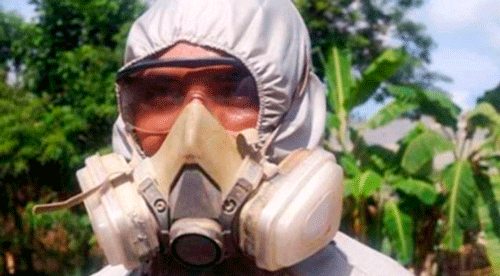
Taken from: https://www.agro-tecnologia-tropical-com
Respiratory protection
Respiratory protection masks can cover half of the face, nose and mouth or the entire face, namely the nose, mouth and eyes. Its function is to prevent hazardous agrochemicals from being breathed. A mask filtering device suppresses dangerous substances by absorption, adsorption or simple filtration. The filtration is carried out by means of a simple metallic screen. Since we are dealing with highly dangerous agrochemical substances, the air is filtered through a tube or filter containing other chemicals (activated carbon) that fix dangerous particles. Users must ensure that the mask fits snugly into the nose and mouth and that they have received sufficient information and instructions on its correct use and maintenance. Tubes must be periodically renewed and masks must be regularly replaced so as to ensure protection.
Types of masks used to apply agrochemicals:
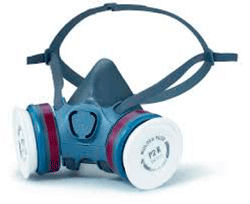
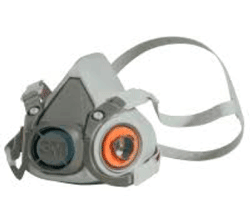
Protective gloves
Gloves are required when handling concentrated agrochemicals, particularly pesticides. It is very common for these to be absorbed through the skin or to cause burns. They must be at least 0.4 mm thick, without losing flexibility for manual and simple tasks such as opening containers or changing nozzles. The type of glove for a particular activity will depend on the agrochemical substance and the extension of the contact time. For example, gloves that cover the wrist may be required for the conventional application of toxic pesticides, gloves that reach the elbow for the handling of granules and gloves that reach the shoulder for the immersion of plants in pesticides. In general, garments such as gloves made of neoprene, nitrile or viton must have a thickness of not less than 0.4 mm, being resistant to most of the agrochemical products. The overall sleeves should be placed on the gloves, so that the pesticide, in case of dripping, fall to the ground and not inside the glove.
 Taken from: www.agro-tecnologia-tropical.com
Taken from: www.agro-tecnologia-tropical.com
Work clothes
These are personal garments that are worn at work, while using agrochemicals. They include such items as shirts, pants, skirts, socks and shoes or boots. In many occasions, clothing will be the main skin coverage, for example when using low risk products applied to the treatment of animals.
Work clothes used when handling agrochemicals should always be kept clean, being washed immediately after use. Garments contaminated with agrochemicals can cause poisoning or skin irritation.
In general, work clothes must:
- Be comfortable in order to allow the body and limbs free motion, without undue difficulties;
- Be carried by the same person every day and not exchanged between individuals;
- Be in good conditions, sewn or patched, when necessary;
- Be clean and devoid of agrochemicals deposits. A dirty work garment must be cleaned separately from the family wash;
- Be worn under protective clothing so that they are completely covered and not exposed to accidental contamination
- Stored separately from protective clothing, in order to avoid cross-contamination.
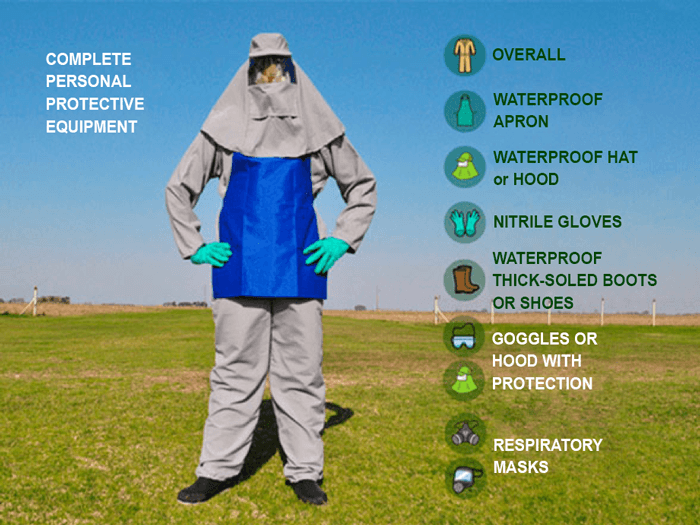
Taken from: Casafe
Bibliography:
Johnson, M; Easter, E., Horstman, H. sf. Equipo protector personal para los aplicadores de pesticidas. Agriculture, Food and Environment. University of Kentucky. Traducido por Megan L. Potter. https://entomology.ca.uky.edu/pat6esp
Fishel, F. 2015. Equipo de Protección Personal para la Manipulación de Pesticidas 1. Departamento de Agronomía, Instituto de Alimentos y Ciencias Agrícolas, Universidad de Fl.
Paunero I. Que sabemos sobre el uso seguro de agroquímicos. INTA. Argentina. https://es.slideshare.net/gastonmeza/uso-seguro-de-agroqumicos
Programa internacional de Seguridad en las Sustancias Químicas. Guía sobre seguridad y salud en el uso de productos agroquímicos. sf. https://training.itcilo.it/actrav_cdrom2/es/osh/kemi/pest/pesti3.htm
The information shared here is the property of CropLife Latin America and is protected by copyright. Reproduction, adaptation, distribution, commercial or otherwise, by any means, printed or digital, without the prior written consent of CropLife Latin America is prohibited.
Terms and conditions of use.
The purpose of this article is to give general information. At no time does the content aim to have a technical or professional aspect. CropLife Latin America and its affiliates, both companies and associations, are not liable for personal or material losses or damages, in the present or future, derived from the use or interpretation of the information contained in this document. The person reading this document can only do it under their responsibility and must go refer to their technical advisor for their due independent and individualized advice, in case of doubts.








